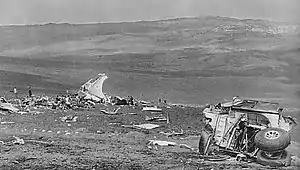Japan Air Lines Flight 301
The crash of Japan Air Lines Flight 301 was an accident involving a Martin 2-0-2 of the Japanese airline Japan Air Lines on Mount Mihara, Izu Ōshima, Japan on 9 April 1952, killing all 37 people on board.[1]
 The wreckage of Flight 301 at the crash site | |
| Accident | |
|---|---|
| Date | 9 April 1952 |
| Summary | CFIT for reasons unknown |
| Site | Mount Mihara, Izu Ōshima, Japan |
| Aircraft | |
| Aircraft type | Martin 2-0-2 |
| Aircraft name | Mokusei-go (Jupiter) |
| Operator | Japan Air Lines |
| Registration | N93043 |
| Flight origin | Tokyo-Haneda Airport (HND/RJTT), Japan |
| Stopover | Itami Airport (ITM/RJOO), Japan |
| Destination | Fukuoka Airport (FUK/RJFF), Japan |
| Occupants | 37 |
| Passengers | 33 |
| Crew | 4 |
| Fatalities | 37 |
| Injuries | 0 |
| Survivors | 0 |
Accident
Flight 301 took off from Tokyo-Haneda Airport in Tokyo, Japan in the morning of 9 April 1952 on a scheduled flight to Fukuoka Airport in Fukuoka, Japan with a stopover in Itami Airport, Japan, carrying 4 crew and 33 passengers. While flight 301 was cruising approx. 62 miles (100 km) South of Tokyo in marginal weather conditions, the aircraft crashed into the slope of Mount Mihara on Izu Ōshima at 8.07 am. The plane's wreckage was discovered several hours after the crash, which revealed that none of the 37 people on board the flight survived the crash.[2]
Aircraft

The Martin 2-0-2 involved, registered N93043 (msn 9164) and named Mokusei-go (もく星号, Jupiter), was built in 1947 and was used by Japan Air Lines during its final flight after having been leased from Northwest Airlines.[1]
Aftermath
The aircraft was destroyed in the accident, while all 37 occupants of the flight were killed. An investigation of the accident by the Japanese government aircraft accident investigation committee was hampered by the occupation authorities due to their refusal to provide a tape recording of the conversations between the ATC at Haneda Airport and Flight 301. Alongside the fact that flight 301 was not equipped with either a CVR or a FDR, the exact cause of the crash could not be determined. The committee proposed that the only evidence they had, which was that the aircraft had deviated from its original course, suggested that the cause of the accident was due to a navigational error by the pilots of flight 301.[2]
References
- "Accident Description". aviation-safety.net. 1996. Retrieved 4 December 2022.
- "ACCIDENT INVESTIGATION REPORT". baaa-acro.com. 1990. Retrieved 4 December 2022.
External links
![]() Media related to Japan Air Lines Flight 301 at Wikimedia Commons
Media related to Japan Air Lines Flight 301 at Wikimedia Commons